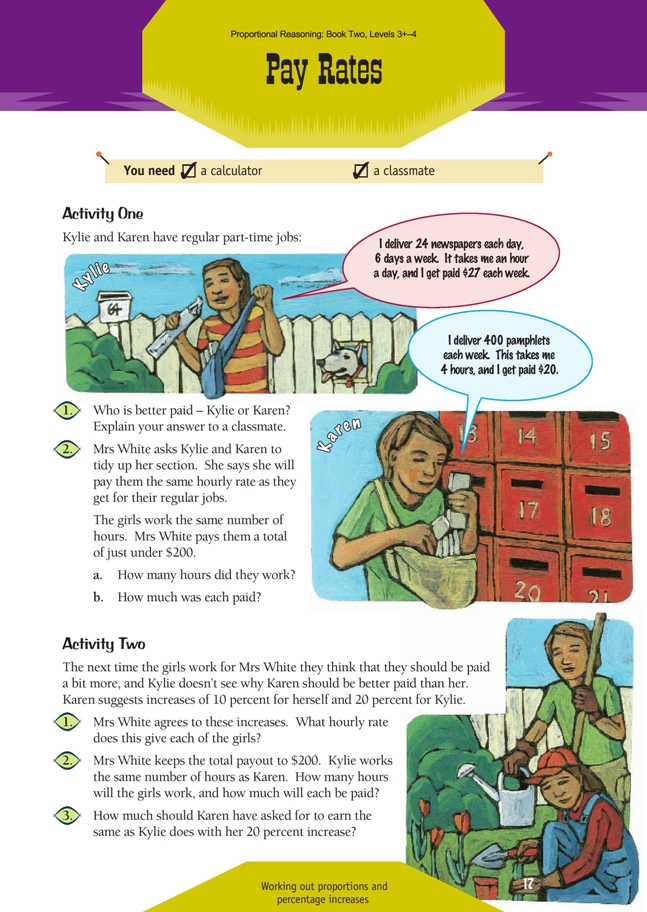This is a level 5 number activity from the Figure It Out series. It relates to Stage 8 of the Number Framework.
A PDF of the student activity is included.
Click on the image to enlarge it. Click again to close. Download PDF (1204 KB)
solve problems involving proportions
Number Framework Links
Use this activity to:
• encourage the transition from advanced multiplicative strategies (stage 7) to advanced proportional strategies (stage 8)
• help students consolidate and apply their knowledge of percentages (stage 8)
• develop confidence in students who are beginning to use advanced proportional strategies (stage 8).
FIO, Level 3-4+, Proportional Reasoning, Book Two, Pay Rates, page 17
A classmate
Activity One
In this activity, students meet rates in a context of time worked and pay. Use problem-solving groups of not more than four to sort out the information needed for question 1 and then get the students to discuss and share strategies that might lead to a solution. Check that they have found the correct answers to question 1 because they are needed in the questions that follow.
If the students plan to use a trial-and-error strategy to solve question 2, get them to make a sensible estimate first; this will encourage the more thoughtful approach described as trial and improvement.
A simple estimate can be made by noting that the girls both earn around $5 an hour. This means that Mrs White must be paying out at the rate of about $10 an hour. If this is the case, both must work for about 20 hours (10 x 20 = $200).
If the students now take the estimate of 20 hours as a starting point, they find that $5 x 20 = $100, $4.50 x 20 = $90, and $100 + $90 = $190. This leaves $10, so the girls must have worked 1 more hour: 20 + 1 = 21 hours.
Alternatively, the students could combine the girls’ pay and see that Mrs White is paying out a total of $9.50 per hour. 200 ÷ 9.5 = 200 ÷ 9 = 400 ÷ 19. A strategy for dividing 400 by 19 might go like this: 190 ÷ 19 = 10, and another 190 ÷ 19 = 10. That means 380 ÷ 19 = 20, which leaves 20 ÷ 19 = 1 and a little bit. So the girls must both work 21 hours. It’s a short step from here to the answer for question 2b.
Activity Two
In question 1, the girls’ pay rates are adjusted. For Karen, the increase is 10%. This can be thought of as an addition: 10% of $5.00 is 50c; adding 50c to $5.00 gives $5.50 per hour. But encourage your students to think multiplicatively when making percentage increases or decreases and to express the mathematics in one-step equations. In Karen’s case, the equation is: $5 x 1.10 = $5.50.
In Kylie’s case, the equation is: $4.50 x 1.20 = 4.50 x 1 + 4.50 x 0.20 = 4.50 + 0.90 = $5.40. Students can return to the methods they used in Activity One to find the answers to question 2.
Question 3 extends students’ thinking and should appeal to their sense of justice. Students need to see that Karen’s pay should be $5.40, the same as Kylie’s. They should also see that as a percentage, this increase must be less than the 10% that Karen was awarded. The increase from $5.00 is 40 cents. Here is one strategy for working out what this increase of 40 cents is as a percentage:
“1% of $5.00 is 5c. 5c x 8 = 40c. So Karen’s increase should have been 8% (8 x 1%).”
Have the students share their different ways of solving the question. Restate their explanations to clarify them and then record them, using numbers, on a chart or whiteboard.
Answers to Activities
Activity One
1. Kylie gets more pay, but Karen gets paid more per hr. (Kylie earns 27 ÷ 6 = $4.50/hr; Karen earns 20 ÷ 4 = $5.00/hr.)
2. a. Kylie is paid $4.50/hr and Karen $5.00/hr, so Mrs White must be paying
4.50 + 5.00 = $9.50/hr. 200 ÷ $9.50 = 21.05 hrs, so Mrs White must
be paying the girls for 21 hrs each, at a total cost of 21 x 9.50 = $199.50.
b. Kylie is paid 21 x 4.50 = $94.50 and Karen is paid 21 x 5.00 = $105.00.
Activity Two
1. Karen gets $5.50. (5.00 + 0.50 = $5.50)
Kylie gets $5.40. (4.50 + 0.90 = $5.40)
2. 18 hrs.
(5.50 + 5.40 = $10.90. 200 ÷ 10.90 = 18.35 hrs, or 18 whole hrs.) Karen gets $99.00 (18 x 5.50 = $99.00). Kylie gets $97.20 (18 x 5.40 = $97.20).
3. 8%. (Karen needs to increase her pay from $5.00 to $5.40 to match Kylie’s new rate. This is an increase of 40c for every $5.00 or 8c for every 100c, which is 8%.)
